When Will Vega Be the North Star Again
Polaris, Alpha Ursae Minoris (α UMi), commonly known as the Northward Star, is the closest relatively bright star to the n celestial pole. It lies at an estimated altitude between 323 and 433 calorie-free years (99 to 133 parsecs) from World and has an apparent magnitude that varies between i.86 and ii.13. Information technology is classified every bit a classical Population I (metallic-rich) Cepheid variable and is the nearest star of this kind to Globe.
Polaris is hands visible to the unaided eye, only not exceptionally bright. Information technology is the brightest star in the constellation Ursa Minor, but only the 48th brightest star in the sky. This, however, does not mean that it is non particularly luminous. As a yellow supergiant, the star is immense and only appears faint because it is so distant from Globe.
Star arrangement
Polaris is a triple star system consisting of the yellow supergiant Polaris Aa and two white (spectral type F) main sequence stars, Polaris Ab and Polaris B. Polaris Aa and Ab are in shut orbit with each other and Polaris B is orbiting the pair.
Polaris Aa has the spectral classification F7Ib. It is a supergiant star with 5.4 solar masses and a radius 37.5 times that of the Dominicus. It is 1,260 times more luminous than the Sun with a surface temperature of about 6,000 K. Information technology was the kickoff variable star of its type to have its mass calculated from its orbit.
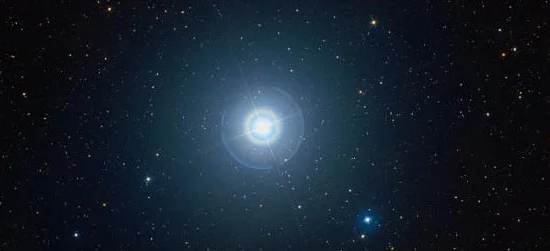
Polaris (Alpha Ursae Minoris), epitome: Wikisky
In 1929, a report of the star's spectrum revealed that Polaris was in fact ii stars in a tight orbit, confirming an before theory that the main component was a binary star.
Polaris Aa is a low-amplitude Cepheid and, being the nearest such star to World, it has been a frequent object of written report. Cepheids are important in astronomy because they are used every bit standard candles – objects with known luminosities – to measure distances. With classical Cepheids, astronomers utilise the relation between their periods and luminosity to determine distances to objects both inside the Galaxy and outside our galaxy. Cepheids were a disquisitional cistron that helped American astronomer Edwin Hubble bear witness that the Andromeda Galaxy (Messier 31) was not a nebula within the Milky Manner, as previously believed, simply an external galaxy.
Classical or Population I Cepheids are typically brilliant giants or low-luminosity supergiant stars with 4 to xx solar masses, 1,000 to 50,000 solar luminosities and a few tens to a few hundred solar radii. They accept the spectral nomenclature of F6 – K2. They are pulsating variable stars whose temperature, radius and spectral type change as they pulsate. Their effulgence changes from a few tenths of a magnitude to 2 magnitudes. These stars have a well-defined period-luminosity relationship; the longer the pulsation menstruum, the more luminous they are.
Astronomers had suspected the primary star in the Polaris system to be a variable since 1852, but its variability was not confirmed until 1911, when Danish astronomer Ejnar Hertzsprung demonstrated it. Hertzsprung went on to determine the distances to several such stars using parallax in 1913. Both his piece of work and Edwin Hubble's relied on American astronomer Henrietta Leavitt's discovery of the flow-luminosity relationship in 1908. Leavitt was investigating variable stars in the Magellanic Clouds at the fourth dimension and published her findings in 1912.
Polaris varies in effulgence from magnitude 1.86 to 2.13, just the amplitude is not the aforementioned as information technology was at the time of discovery. Before 1963, it was more than 0.1 magnitude and slowly decreasing until 1966, when information technology had a dramatic subtract to less than 0.05 magnitude. The amplitude has varied unpredictably since, but stayed close to those values. A newspaper published in 2008 reported that it was increasing again, which is unprecedented in a star of this type.
Polaris Aa has a menstruation of about four days, but the flow has not stayed the aforementioned either. Astronomers noticed a gradual increase by roughly four-5 seconds per year, with a interruption betwixt 1963 and 1965. The star'south temperature varies only slightly equally the star pulsates, but the variation itself is erratic, from l One thousand to 170 K or more. Astronomers have speculated that the unpredictability may exist due to the star's orbit with Polaris Ab.
Polaris Ab orbits the primary star at a distance of 18.8 astronomical units, roughly equal to the altitude between the Sun and Uranus. It belongs to the spectral class F6V, indicating a white main sequence dwarf. It has 1.26 solar masses and a radius 1.04 times solar. It is three times more than luminous than the Sun.
Polaris B orbits the primary pair at a distance of 2,400 astronomical units. It is a master sequence star of the spectral blazon F3V with 1.39 solar masses and 1.38 solar radii. It shines with iii.ix solar luminosities and has an estimated surface temperature of 6,900 G.
Polaris B was discovered by the German-built-in British astronomer William Herschel in Baronial 1779 using a reflector telescope. The star can exist observed even in modest-sized telescopes.
At i time, astronomers believed at that place were two other, more than distant stars in the system, designated Polaris C and Polaris D, but these stars were later discovered to not be physically related to the three components of the Polaris system.
In Jan 2006, images taken by the Hubble Infinite Telescope showed all iii members of the Polaris star system. Information technology was the first time the close companion was seen directly.
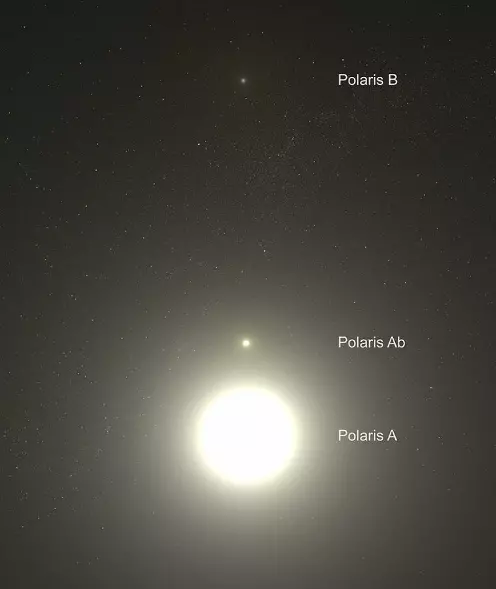
Polaris star system imaged by the Hubble Space Telescope, credit: NASA/ESA/HST, G. Bacon (STScI)
N Star
Polaris does not mark the exact location of the north celestial pole, but it is very close to information technology. It lies in line with the Earth's northern axis of rotation, most directly to a higher place the North Pole and, for hypothetical observers at the pole, the star would be directly overhead. With the rotational axis pointed almost direct at the star, Polaris does not rise or set for northern observers. Because it is so about the north celestial pole, it appears motionless in the sky and other stars appear to movement in a circle around it. This makes Polaris highly useful in navigation and astrometry.
Polaris is currently moving closer to the due north celestial pole. It will come to the closest approach on March 24, 2100 (at declination +89°32'50.62'') and then slowly begin to move away. The star's credible movement is the result of the Globe's centric precession (the precession of the equinoxes), a slow alter in the orientation of the Earth's rotational axis. The gradual shift occurs in a cycle of about 25,772 years and, as a consequence, the pole stars also alter. Polaris is currently the closest visible star to the north celestial pole, merely information technology will non stay the North Star forever, just as Sigma Octantis (Polaris Australis) will not be the marker of true south forever.
Polaris took over as the North Star from Kochab, Beta Ursae Minoris, around the year 500 CE. Kochab, the second brightest star in Ursa Small-scale and the brightest star in the basin of the Piffling Dipper, held the title from 1500 BCE to 100 CE. Today, Kochab and Pherkad, Gamma Ursae Minoris, are known every bit the Guardians of the Pole. The two stars mark the outer border of the Trivial Dipper's pan and appear to rotate effectually Polaris and the north celestial pole.
In tardily antiquity, the pole was at the same angular distance from Polaris as it was from Kochab, and this was the time when Polaris, the brighter of the 2, started to become more important as a navigational star. In antiquity, before Polaris had become the nearest visible star to the pole, the entire Ursa Minor constellation was used for navigation. Polaris moved to inside several degrees of the pole in the early Center Ages, which is when it started being called the "polar star."
Polaris will be succeeded by Errai, Gamma Cephei. Around the year 3000, the pole will be halfway between Polaris and Errai and, around 4200, Errai will achieve its closest point to the pole.
Of all the north stars, Polaris is the 2nd closest to the pole. The simply star that marks true north more accurately as the pole star is Thuban, Blastoff Draconis. Thuban comes within 0.ii° of the pole, while Polaris comes within 0.5°. Still, Thuban is considerably dimmer at magnitude 3.65, which fabricated information technology slightly less useful as a marker when it was the North Star from the 4th to the 2nd millennium BCE. The brightest of the n stars, Vega, has an apparent magnitude of 0.026, but simply comes inside v° of the pole.
Other than Polaris, Errai (Alrai), Vega, Thuban and Kochab, the stars that deed as indicators of true due north or near-north are Iota and Beta Cephei, which share the title of the Due north Star, Alderamin (Alpha Cephei), Deneb (Blastoff Cygni), Fawaris (Delta Cygni), Iota Herculis, Tau Herculis, Edasich (Iota Draconis), and Kappa Draconis, which shares timing with Kochab.
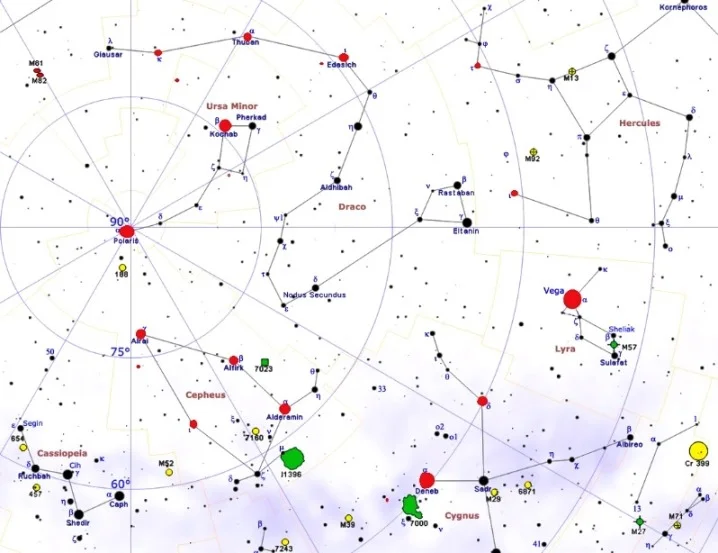
North Stars (marked red), image: Roberto Mura
Polaris volition be the North Star again effectually the year 27800, but information technology volition not be as shut to the pole every bit information technology is now or when information technology had the championship around 23600 BCE and came even closer to the pole than it is at present.
Facts
The proximity of Polaris to the northward celestial pole in the sky means that its distance from the horizon matches the observer's latitude. For observers at the N Pole, the star is directly overhead, and the further south the observer is, the closer the star is to the northern horizon. For case, observers in New York can see it 41 degrees to a higher place the horizon considering the metropolis is located at latitude 41°N.
Polaris is surrounded by a small semicircle of dim stars known as the Engagement Band. Polaris is the diamond in the ring, formed by about x brighter and several fainter stars that can be seen in a small telescope. The stars that grade the asterism belong either to Ursa Modest or to the neighbouring Cepheus constellation.
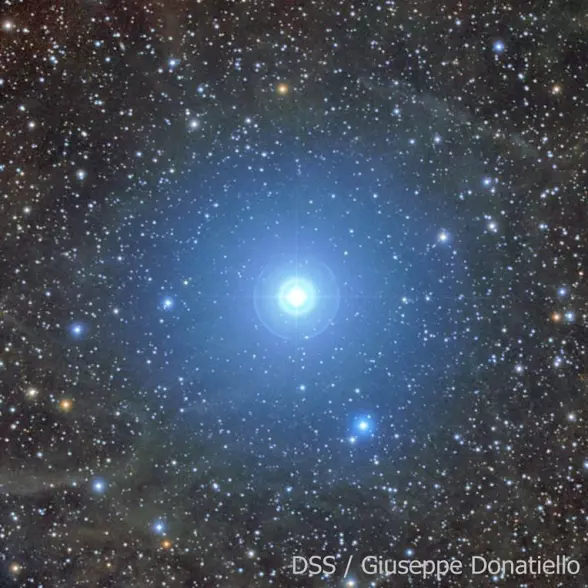
Polaris, epitome: DSS / Giuseppe Donatiello (CC0 1.0)
Polaris' altitude is still uncertain. The revised parallax obtained from the Hipparcos satellite information gives a distance of 433 light years, only older estimates are slightly closer. Recent studies based on spectral analysis also indicate that the star may exist 323 light years (99 parsecs) abroad.
The accuracy of the data collected by the Hipparcos satellite in 1989 and 1993 has been questioned in the cases of Cepheid variables in binary star systems. Even though the data has been re-examined and confirmed, at that place is still no single value that has been widely accepted.
A more recent astrometry mission launched with the Gaia space observatory, the successor to Hipparcos, in 2013 was originally limited to stars dimmer than magnitude 5.vii, but proved to work even with magnitude 3 stars. The Gaia Data Release 2 did non provide a parallax for Blastoff UMi A, but the distance estimate deduced from information technology is 136.half dozen ± 0.v parsecs (443.57 calorie-free years) for Blastoff UMi B. The estimate places the star further abroad than previous ones, only is significantly more accurate.
Research conducted in the last two decades suggests that Polaris is 4.6 times brighter today than it was at the time Ptolemy observed it (137 CE). A team of scientists began to monitor the star in 1999 and discovered that, later on reaching a minimum, the aamplitude of the star's pulsations was increasing again. Equally they researched historical records, they discovered that the star was fainter the further back they went.
Cepheids have been very important for a very long time because their consistency allows astronomers to use them as standard candles. Nonetheless, Polaris is not the simply star of this type found to exhibit unexpected changes in its brightness in the long term. Virtually of the 15 other Cepheids included in the written report showed similar changes, which indicates that these stars are more circuitous than previously believed.
Name
The proper noun Polaris is short for stella polaris, Latin for "polar star." The name dates back to the Renaissance era, when Polaris came within a few degrees of the north celestial pole. The Dutch physician, geographer and mathematician Gemma Frisius mentioned the star as "stella illa quae polaris dicitur," or "the star which is called 'polar'" in 1547. He determined the star's distance from the pole to be iii°7'.
The International Astronomical Union's (IAU) Working Group on Star Names (WGSN) officially approved the proper name Polaris for Blastoff Ursae Minoris Aa on June thirty, 2016.
Polaris has been known by many other names throughout history. The star's name in Old English language was scip-steorra, or "send-star," and an fifty-fifty older proper noun was lodestar, pregnant "guiding star." The Old Norse name leiðarstjarna and Center High German leitsterne share the aforementioned linguistic root. In the late 13th century, the star became known equally Stella Maris, or "the star of the sea."
By the early modern flow, the name Cynosura was also used for the star. It is the old name for the constellation Ursa Minor, derived from the Greek κυνόσουρα, pregnant "the dog's tail." The constellation was associated with a dog, not a bear, in ancient times.
In Hindu Puranic literature, Polaris was known as Dhruva, which means "immovable" or "stock-still."
The old Arabic name for the star was Al-Judeyy. The proper noun dates dorsum to pre-Islamic astronomy, earlier Polaris was as close to the pole as it is today.
Medieval Islamic astronomers knew the star by several different names: Mismar ("needle" or "nail"), al-kutb al-shamaliyy ("the northern beam"), and al-kaukab al-shamaliyy ("the north star").
In the Berber language of the Tuareg people in North Africa, Polaris is known equally Tatrit tan Tamasna, or "star of the plains." The name reflects the star's prominent part in navigating the great deserts.
The Inuit proper noun for Polaris is Niqirtsuituq. The star is depicted both on the flag of the Inuit territory of Nunavut, the northernmost territory of Canada, and on the flag of Alaska, the northernmost state of the Usa.
Location
Polaris is quite easy to find because it is relatively bright and part of the Little Dipper, a familiar northern asterism. However, since the other stars that form the Little Dipper are fainter than Polaris and cannot be seen from urban locations, information technology is easier to use the stars of the larger and brighter Large Dipper to find Polaris and truthful due north. Dubhe (Alpha Ursae Majoris, mag. one.79) and Merak (Beta Ursae Majoris, mag. 2.37), the 2 stars at the end of the Big Dipper'southward basin, are commonly used to notice the star. They are known as the Pointer Stars considering an imaginary line extended from Merak through Dubhe leads direct to the North Star.
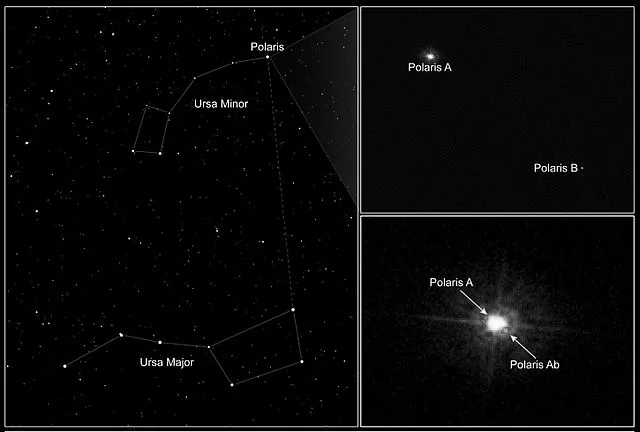
Polaris (Alpha Ursae Minoris) equally seen by the Hubble Space Telescope, image: NASA/HST
The distance from Dubhe to Polaris is nigh five times the altitude from Merak to Dubhe. Polaris is the brightest star in that direction. The two other relatively vivid stars in this expanse of the sky are Kochab and Pherkad, the Guardians of the Pole. The Arrow Stars always bespeak toward Polaris every bit the Large Dipper keeps going effectually it. The Dipper stars take 23 hours and 56 minutes to complete a circle around the star.
Constellation
Polaris is the luminary of Ursa Minor and marks the tip of Smaller Bear'due south tail. In the Little Dipper asterism, information technology is the star at the end of the handle.
Ursa Minor is one of the Greek constellations, easily recognizable for the Little Dipper asterism on a articulate, nighttime night. It is one of the smaller constellations, only the 56th in size. Like its neighbours Cepheus and Draco and the larger Ursa Major, Ursa Minor is circumpolar to northern observers, which means that it can be seen year-round from locations north of the equator.
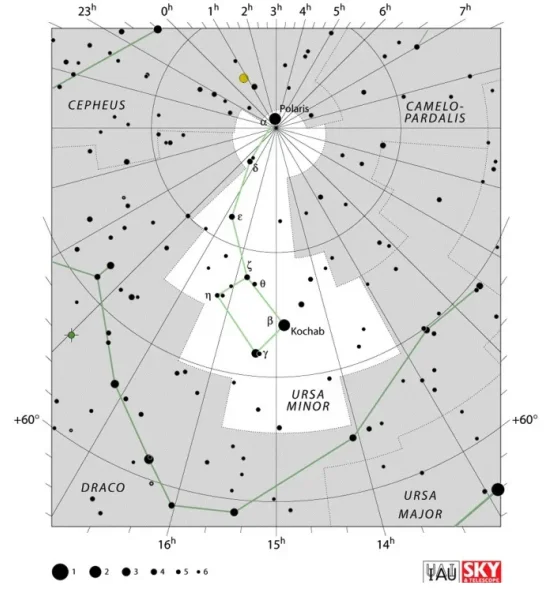
Ursa Minor constellation map by IAU and Sky&Telescope mag
Ursa Minor does not contain any particularly vivid deep heaven objects. Notable galaxies in the constellation include the Ursa Minor Dwarf (mag. 11.9), a dwarf spheroidal galaxy discovered in 1955, the barred screw milky way NGC 6217 (magazine. eleven.ii), and the supergiant elliptical radio milky way NGC 6251 (magazine. xiv.3).
The best fourth dimension of yr to come across the stars and deep sky objects of Ursa Pocket-size is during the month of June.
The 10 brightest stars in Ursa Minor are Polaris (Alpha UMi, mag. i.86 – 2.xiii), Kochab (Beta UMi, magazine. ii.08), Pherkad (Gamma UMi, mag. 3.05), Epsilon Ursae Minoris (mag. 4.xix), 5 Ursae Minoris (mag. four.253), Zeta Ursae Minoris (mag. 4.32), Yildun (Delta UMi, mag. 4.36), RR Ursae Minoris (magazine. 4.44 – 4.85), 4 Ursae Minoris (mag. 4.80), and Eta Ursae Minoris (mag. 4.95).
Polaris – Blastoff Ursae Minoris
| Distance | 323 – 433 calorie-free years (99 – 133 parsecs) |
| Parallax | 7.54 ± 0.11 mas |
| Radial velocity | -17 km/s |
| Proper motion | RA: 198.viii ± 0.twenty mas/yr |
| Dec.: -15 ± 0.30 mas/yr | |
| Constellation | Ursa Pocket-size |
| Designations | Polaris, Alpha Ursae Minoris, α UMi, North Star, 1 Ursae Minoris, Cynosura, Navigatoria, Star of Arcady, Phoenice, Mismar, Yilduz, Alruccabah, Hour 424, HIP 11767, ADS 1477, SAO 308, HD 8890, GC 2243, BD +88° 8, FK5 907, CCDM J02319+8915, GCRV 1037, TYC 4628-237-ane, IRAS 01490+8901, Gaia DR2 576402619921505664 |
Blastoff Ursae Minoris Aa
| Spectral course | F7Ib |
| Variable type | Classical Cepheid |
| U-B colour index | 0.38 |
| B-V colour alphabetize | 0.60 |
| Apparent magnitude | 1.98 (1.86 – ii.13) |
| Absolute magnitude | -3.6 |
| Mass | 5.four G☉ |
| Luminosity | i,260 50☉ |
| Radius | 37.5 R☉ |
| Temperature | six,015 M |
| Age | 70 million years |
| Surface gravity | 2.2 cgs |
| Rotational velocity | 14 km/southward |
| Correct ascent | 02h 31m 49.09southward |
| Declination | +89° 15′ 50.8" |
Alpha Ursae Minoris Ab
| Spectral class | F6V |
| Credible magnitude | nine.2 |
| Accented magnitude | three.vi |
| Mass | 1.26 One thousand☉ |
| Luminosity | 3 L☉ |
| Radius | 1.04 R☉ |
| Historic period | 70 million years |
Alpha Ursae Minoris B
| Spectral class | F3V |
| U-B colour index | 0.01 |
| B-V color index | 0.42 |
| Apparent magnitude | 8.7 |
| Absolute magnitude | three.1 |
| Mass | one.39 Yard☉ |
| Luminosity | 3.ix L☉ |
| Radius | 1.38 R☉ |
| Temperature | 6,900 K |
| Age | seventy million years |
| Surface gravity | four.3 cgs |
| Rotational velocity | 110 km/south |
| Right rising | 02h 30k 41.63s |
| Declination | +89° fifteen′ 38.ane" |
| Designations | BD+88 7, GC 2226, SAO 305, GCRV 1031 |
stephensondoorcall.blogspot.com
Source: https://www.star-facts.com/polaris/